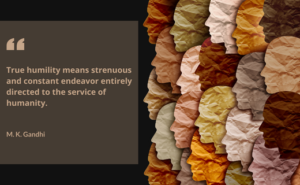These are my musings and deeply held introspections on some of the external factors that impact research but are often not acknowledged or addressed as it relates to its impact. Let’s get into it.
SHAME…
Shame is closely related to guilt, but there is a key qualitative difference. No audience is needed for feelings of guilt; no one else needs to know, for the guilty person is his judge. Not so for shame. The humiliation of shame requires disapproval or ridicule by others …. The wish to relieve guilt may motivate a confession, but the wish to avoid shame or humiliation may prevent it.
Paul Ekman
We feel guilty for what we do. We feel shame for what we are.
Lewis B. Smedes
Shame derives its power from being unspeakable …. If we can share our story with someone who responds with empathy and understanding, shame can’t survive.
Brené Brown
Shame Rears Its Ugly Head
Recently, I spoke with one of my mentees about the impact of shame on how the populations we research “show up”, and what that means holistically for the validity of the research. My mentee was previously an EMT in an urban area, where she went on many 911 calls for overdose victims.
Often, she would show up to a potential overdose, and the persons being questioned did not feel comfortable giving honest answers about their or the victim’s drug use or past overdoses. Even when the stakes were so high, the shame attached to drug use was too intense and interfered with the ability to save lives.
Shame & Its Relationship to Social-Desirability Bias
The role of shame is vital when we account for social-desirability bias and impression management in our work. Social-desirability bias is a person’s tendency to respond in ways that they feel are more appropriate or socially acceptable to others.
At the same time, impression management is the purposeful presentation of self to fit into a situation or please an audience – and is often motivated by the desire to avoid embarrassment and repercussions from disclosing sensitive information.
Empowering Participants & Mitigating Social-Desirability Bias
My mentee’s stories call to mind researcher Richard C. Stephens’ studies on heroin addiction. In “The Street Addict Role: A Theory of Heroin Addiction”, Stephens proposes that the “street addict” role is a central attribute of substance users’ relationships.
In the role of “street addict”, providing misinformation and hustling are appropriate. Consequently, the role of “street addict” may lead to problematic self-reports if research is seen as a hustle.
With this in mind, we should be mindful to present our research as beneficial to participants in more ways than just a monetary reward. Participating in our research is also an opportunity to be listened to and honestly heard, to have their experiences and beliefs valued, and to know that they are providing us with powerful, significant knowledge that we could not get elsewhere.
Shame Gets in the Way of Insights
Many years ago, I was conducting research with at-risk Black and Hispanic urban youths. We meticulously crafted the research and took time to engage, listen, and hold a sacred space for every story, opinion, and outreach.
This was probably one of the most profound research experiences I have had in my career. I cried at the support group of mothers who had lost children to urban violence; their incurable pain was so evident.
Over time, I developed respectful, overstanding relationships with all the participants. After six months of exploratory research and insights, we tested our messaging with the target audience and began an extensive round of interactions.
This work felt meaningful and effective until shame reared its ugly head and forever shifted my paradigm regarding how we gather data and insights.
I was testing messages with at-risk teenagers at an urban community center in an area with one of the highest crime rates in this particular city. The teenagers gave me a hard time, as expected. It did shake me up a bit, but I got through it.
As I was packing up the storyboard, one of the trusted community messengers pulled me aside to share his personal story about urban violence. I stood listening to him as he told me about the personal graphic and abusive experiences he had experienced or witnessed firsthand.
His experience was one that I am sure other participants had experienced (out of his privacy, I cannot share details). I was astonished by his courage to share such intensely personal trauma.
Still, I was also disheartened that shame did not allow others to do the same. His story completely changed the direction of the messaging.
It was the key to understanding secrecy, snitching, and masculinity issues for Black and Hispanic urban men. Yep – I got all of that out of this one conversation.
Using the Right Approach to Avoid Shame & Social-Desirability Bias
After that experience, I became more invested in getting past people’s shame to reach their truths. I wonder how shame impacts our work with topics like HIV, sexual health, social media usage, financial inclusion, and entrepreneurship.
Many views and experiences we ask participants to share touch upon weighty issues like race, sexuality, health, finances, and stigmatized behaviors like drug use. We have learned to avoid response bias and mitigate shame by carefully wording questions, assuring anonymity, and combining different data collection methods.
Roundabout questioning allows participants to share behaviors or attitudes they would not feel comfortable sharing directly via pointed one-on-one questions. By integrating different discussion tools and activities (such as vignettes, dilemmas, and hypothetical or third-party scenarios), we can effectively depersonalize questions and allow participants to move past shame and answer honestly.
We often combine self-administered online diary studies followed by face-to-face interviews or focus groups. This gives participants the space to become more comfortable discussing a sensitive or personal topic.
The participants can express their views/experiences more freely, and our researchers can enter the face-to-face research phase with a more honest understanding of whom we are speaking with.
“Statistically Significant” Sampling vs. Basing Insights on Curated Information
I often hear of the need for “statistically significant” sampling, but is it “significant” if the sample responses are filtered with shame?
Often, we can gain more honest insights from curated one-on-one interviews or quads (mini-focus groups) than from larger focus groups of 10 to 12 participants. The more people present in a research session, the more likely this social-desirability bias will become a factor.
Not accounting for shame and social-desirability bias can lead to inaccurate and erroneous insights. Moving through shame is delicate and takes time, but it is crucial.






